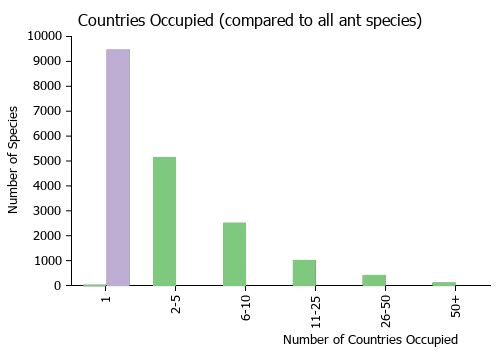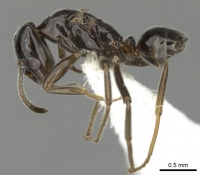Azteca nanogyna
| Azteca nanogyna | |
|---|---|

| |
| Scientific classification | |
| Kingdom: | Animalia |
| Phylum: | Arthropoda |
| Class: | Insecta |
| Order: | Hymenoptera |
| Family: | Formicidae |
| Subfamily: | Dolichoderinae |
| Tribe: | Leptomyrmecini |
| Genus: | Azteca |
| Species group: | aurita |
| Species: | A. nanogyna |
| Binomial name | |
| Azteca nanogyna Longino, 2007 | |
Azteca nanogyna is known from a single queen collected in tropical moist forest. John Noyes collected the specimen using a screened sweep net. The extremely small size of this queen suggests the possibility that A. nanogyna is a workerless social parasite.
Identification
A member of the Azteca aurita group. Azteca nanogyna has by far the smallest queen of any known species in the genus. The color and narrow head clearly ally it with Azteca lanuginosa and Azteca schimperi.
Keys including this Species
- Key to Azteca aurita group queens
- Key to Azteca aurita group workers
- Key to Costa Rica Azteca queens
- Key to Costa Rica Azteca workers
Distribution
Latitudinal Distribution Pattern
Latitudinal Range: 10.96666667° to 10.96666667°.
| North Temperate |
North Subtropical |
Tropical | South Subtropical |
South Temperate |
- Source: AntMaps
Distribution based on Regional Taxon Lists
Neotropical Region: Costa Rica (type locality).
Distribution based on AntMaps
Distribution based on AntWeb specimens
Check data from AntWeb
Countries Occupied
| Number of countries occupied by this species based on AntWiki Regional Taxon Lists. In general, fewer countries occupied indicates a narrower range, while more countries indicates a more widespread species. |

|
Estimated Abundance
| Relative abundance based on number of AntMaps records per species (this species within the purple bar). Fewer records (to the left) indicates a less abundant/encountered species while more records (to the right) indicates more abundant/encountered species. |

|
Biology
|
Castes
Known only from the queen holotype specimen.
Queen

| |
| . | |
Nomenclature
The following information is derived from Barry Bolton's Online Catalogue of the Ants of the World.
- nanogyna. Azteca nanogyna Longino, 2007: 57, figs. 4A, 9 (q.) COSTA RICA.
- Type-material: holotype queen.
- Type-locality: Costa Rica: Prov. Guanacaste, Estacion Maritza, Guanacaste Conservation Area, 10°58’N, 85°30’W, 600 m., 23.ii.2003 (J.S. Noyes).
- Type-depository: INBC.
- Status as species: Guerrero, et al. 2010: 54 (in key).
- Distribution: Costa Rica.
Unless otherwise noted the text for the remainder of this section is reported from the publication that includes the original description.
Description
Queen
Holotype. HLA 0.86, HLB 0.91, HW 0.64, SL 0.58, EL 0.22, OC 0.04, MTSC 6 (very fine, short).
Palpal formula 4,3; middle and hind tibia lacking apical spur; dorsal surface of mandible smooth and shiny, pubescent; medial clypeal lobe strongly convex and protruding, extending well beyond lateral clypeal lobes; head subrectangular, somewhat swollen between ocellar region and compound eye, posterior margin a smoothly rounded excavation; petiolar node bluntly triangular; posteroventral petiolar lobe very low, very shallowly convex, ending posteriorly in a somewhat abrupt shelf, rising steeply to tergosternal suture, leaving small posterior rim on sternite; entire body covered with uniform vestiture of sparse, white, suberect pubescence; scape, all margins of head, legs, petiole, and first gastral tergum with evenly distributed short, white, erect setae emerging above pubescence, similar but sparser setae on mesosomal dorsum; body dark brown becoming lighter brown on mandibles, legs; body with smooth, highly polished and reflective surface.
Type Material
Holotype queen: Costa Rica, Prov. Guanacaste, Estacion Maritza, Guanacaste Conservation Area, 10°58'N, 85°30'W, 600m, 23 Feb 2003 (J. S. Noyes) Instituto Nacional de Biodiversidad, specimen code JTLC000004288
Etymology
The name refers to the small size of the queen.

